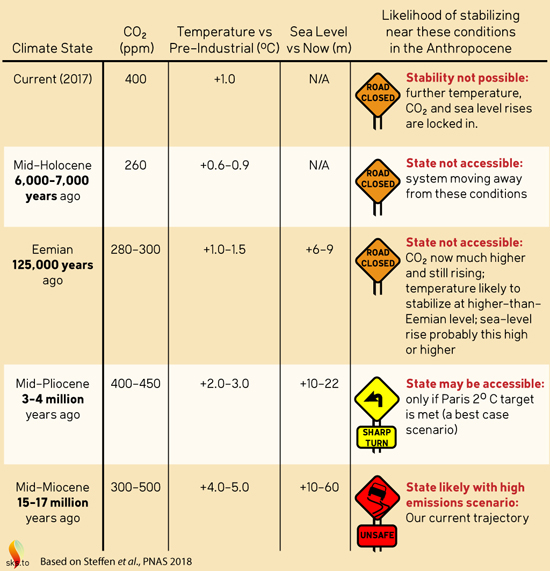
The graphic below (click on it for a large version) is adapted from a table in the supporting information from a newly published paper in Proceedings of the National Academy of Sciences (PNAS). Trajectories of the Earth System in the Anthropocene, as the paper is entitled, looks at several climate states - the present day, the mid-Holocene, the relatively warm Eemian interglacial and, heading back a bit further into geological time, the mid-Pliocene and mid-Miocene. Data are from palaeoclimate studies. The right-hand column assesses our chances of stabilising our climate at these states in the coming decades. In some cases, it is already too late - we have gone beyond the physical parameters that support such climates:
Data details: atmospheric CO2, temperature anomaly relative to the pre-industrial era and sea-levels relative to now measured and from palaeoclimate records. The graphic, created by "JG", is adapted from Table S1 from the paper's supporting information section, available here. Data sources are fully referenced.
Trajectories of the Earth System in the Anthropocene, written by Will Steffen together with a large interdisciplinary team of colleagues, was published on 6th August in PNAS and has made quite an impact. Certain sections of the media used terms like "runaway global warming" in their headlines, which could be taken by some to imply that the paper says we are going to take Earth to a Venus-like state (it doesn't and we aren't). In fact, the term "runaway" does not appear, either in the main paper or the supporting information, as a quick word-search will demonstrate. However, the possibility that we may nevertheless end up on an unstoppable path to a Hothouse climate-state is something that cannot be ignored. The authors describe examples of how such trajectories could occur, in the main body of the paper.
Hothouse in fact describes Earth's climate state throughout much of geological time, especially in the Phanerozoic (541 million years ago-present day). Icehouse climates, during which glacials and interglacials alternate, are relatively uncommon along the time-line and were often short-lived (in geological terms, that means a few million years). The big problem we have is that we happened to develop as a species during an icehouse climate, and especially during a relatively stable interglacial - the Holocene - during which we have created a widespread high-tech and interdependent infrastructure (i.e. civilisation as we know it), much of which is rooted to the ground. A transition, over the coming centuries, towards Hothouse essentially means an ongoing battle with us on the one side and changing weather-patterns and rising seas on the other, until there is no more Polar or mountain ice left to melt. Chaos, in other words.
Through our activities, especially our intensive burning of the various fossil fuels, CO2 levels in Earth's atmosphere have changed from the 180-300ppm range of the glacial-interglacial cycles, to more than 400ppm, a concentration last seen in the Pliocene. The Pliocene was the period of geological time immediately prior to the onset of the glacial-interglacial cycles of the Pleistocene. Beginning 5.33 million years ago, after the Miocene, and ending 2.58 million years ago, the Pliocene featured a notable period of warmth around the middle of the period, during which boreal forests flourished in the Arctic (see this post from 2013 to learn how that was discovered).
Mid-Pliocene Earth and its climate are of particular interest, because global continental configurations were remarkably similar to those of today. We therefore know that a 400ppm CO2 world, with a near-identical geographical layout, is eventually a much warmer one than the Earth which we are familiar today: it takes time for the planet to catch up - head towards equilibrium with - such atmospheric changes. As the table shows, though, we have taken the atmosphere well beyond anything closely resembling the interglacial-glacial cycles, so that it is towards the mid-Pliocene climate we are, decade by decade, heading. It is the past, not climate models, that is speaking out here. Geological evidence should never be ignored, because it tells us what actually happened.
If we drastically cut emissions right now, Earth will gradually come towards equilibrium with that 400ppm atmosphere (or with whatever CO2 level we end up with). There will of course be consequences in the long term as the table shows, with respect to changing weather-patterns and sea-level rise. However, fail to accomplish such cuts and we risk setting in motion various chains of events that will lead us towards that Hothouse state: some of these chains, referred to in the paper as "tipping cascades", may not be stoppable. Although it's been a hot few months in the Northern Hemisphere, the mid-Pliocene was a bit similar: this is something we may have to get used to. But, "let's not make things any worse", sounds like an extremely good idea to me, right now, bearing in mind that our species has never had to deal with the Hothouse climate state.
Posted by John Mason on Friday, 10 August, 2018
 |
The Skeptical Science website by Skeptical Science is licensed under a Creative Commons Attribution 3.0 Unported License. |